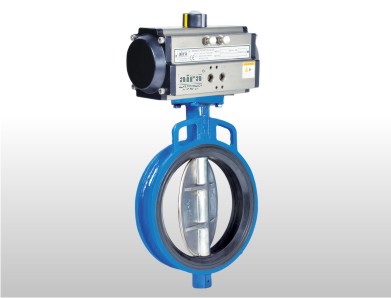What is a Butterfly Valve?
Butterfly valves are quarter-turn valves used to regulate the flow of fluids, gases, or slurries in a pipeline. They are called butterfly valve because their disc, which acts as the closure element, resembles a butterfly’s wings. The disc is mounted on a shaft that passes through the valve body, and when rotated, it can control or isolate the flow of the medium.
Types of Butterfly Valve
There are several types of butterfly valves available, but the most common ones are:
- Wafer Type Butterfly Valve: These are lightweight, compact, and easy to install between flanges. They are suitable for low-pressure applications and are preferred in HVAC systems, water treatment plants, and other industrial processes.
- Lug Type Butterfly Valve: These valves have threaded inserts on both sides of the valve body, making them suitable for end-of-line service. They are useful in applications where the valve needs to be installed or removed without disturbing the rest of the pipeline.
- Double Offset Butterfly Valve: These valves have an offset shaft and an offset disc, which reduce the amount of friction and wear. They are used in high-temperature, high-pressure applications, and are preferred in the chemical, petrochemical, and oil and gas industries.
- Triple Offset Butterfly Valve: These valves have a cone-shaped disc that creates a bubble-tight seal when closed. They are used in critical applications where leakage cannot be tolerated, such as in power plants, refineries, and offshore platforms.
Advantages of Butterfly Valve
Butterfly valves have several advantages over other types of valves, including:
- Low Cost: Butterfly valves are less expensive than other types of valves, such as globe valves or gate valves.
- Lightweight and Compact: Butterfly valves are lightweight and compact, making them easy to install and handle.
- Easy to Operate: Butterfly valves require only a quarter turn to open or close, making them easy to operate and control.
- Low Maintenance: Butterfly valves have few moving parts, which means they require less maintenance and have a longer lifespan.
- Wide Range of Applications: Butterfly valves can be used in a wide range of applications, including water treatment plants, HVAC systems, chemical and petrochemical industries, and power plants.
Applications of Butterfly Valve
A butterfly valve can be used in a variety of applications, including:
- Water Treatment: Butterfly valves are used to control the flow of water in water treatment plants. They are suitable for applications where the flow rate needs to be adjusted frequently.
- HVAC Systems: Butterfly valves are used in heating, ventilation, and air conditioning systems to regulate the flow of air and water.
- Chemical and Petrochemical Industries: Butterfly valves are used in chemical and petrochemical industries to control the flow of corrosive fluids, gases, and slurries.
- Power Plants: Butterfly valves are used in power plants to regulate the flow of steam, gas, and water in boilers, turbines, and other equipment.
In conclusion, butterfly valves are widely used in various industries due to their low cost, easy operation, and low maintenance. With different types of butterfly valves available, it is essential to choose the right type for the application to ensure optimal performance and reliability.


